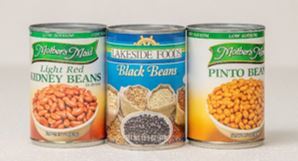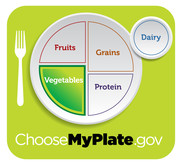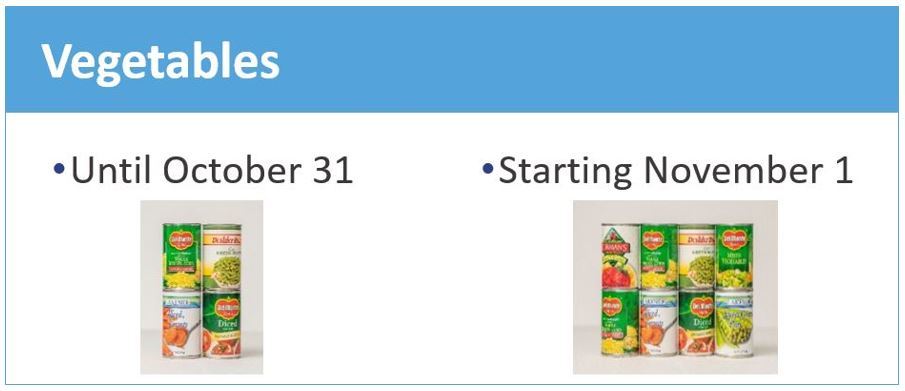
Based on feedback from the Commodity Supplemental Food Program (CSFP) community, the enhanced food package will include canned beans as an option in the plant-based protein category starting November 1, 2019. Canned beans provide a nutritious option in a more convenient, ready to eat form. To offer variety to program participants, three new types of beans will be available in canned form: kidney, black, and pinto. These options will be available in addition to the vegetarian beans that were previously offered as part of the vegetable category. Beans are a very good source of protein, fiber, iron, zinc, potassium, and other nutrients that are beneficial for the health of seniors. We encourage you to talk to your clients about these new options and include them in your plans for distribution under the enhanced food package.
|
The CSFP Food Package provides supplemental foods to help improve the dietary intake of participants. With support from our partners, the USDA Food and Nutrition Service (FNS) conducted a comprehensive review of the package to determine how to enhance the nutrition value. While the enhanced food package is still supplemental, the changes will help the food package better align with MyPlate guidance.
MyPlate recommendations are based on the 2015-2020 Dietary Guidelines for Americans. The focus is on five food groups: fruits, vegetables, grains, protein, and dairy products. This article focuses on the Vegetable Food Group and the nutrition benefits of eating these foods.
 |
|
According to MyPlate, “Any vegetable or 100% vegetable juice counts as a member of the Vegetable Group. Vegetables may be raw or cooked; fresh, frozen, canned, or dried/dehydrated; and may be whole, cut-up, or mashed. Based on their nutrient content, vegetables are organized into 5 subgroups: dark-green vegetables, starchy vegetables, red and orange vegetables, beans and peas, and other vegetables.” Beans and peas are excellent sources of plant protein and other nutrients such as iron and zinc. For this reason, they are also considered part of the Protein Foods Group. |
The enhanced CSFP monthly food package will double the amount of vegetables offered to participants and increase the amount of canned beans, dry beans, or dry lentils that participants may receive. This component of the package will be mentioned in next month’s article focusing on "Protein Foods." We encourage CSFP providers to make a variety of vegetables, beans, and peas available for participants.
 Here are some benefits of eating Vegetable Group Foods:

- Many vegetables are good sources of Vitamin C, Vitamin A, or fiber.
- Foods in the Vegetable Food Group are low in calories, fat, and sodium. Eating more vegetables can replace foods that are higher in calories and fat.
- Foods in the Vegetable Food Group do not have cholesterol.
- Eating more vegetables (and fruits) as part of a healthy diet may reduce your chances of getting heart disease, including heart attacks and strokes.
- Some vegetables (and fruits) may protect against certain types of cancer when eaten as part of an overall healthy diet.
- Foods in the Vegetable Food Group that are good sources of potassium may help to lower blood pressure when eaten as part of an overall healthy diet.
|
The MyPlate website offers a lot of information and guidance, so we invite you to visit ChooseMyPlate.gov for more detailed information. It’s important to remember that MyPlate recommendations at are not written for persons with chronic disease conditions. Those persons should follow the advice of their medical provider or a Registered Dietitian who is familiar with their health status.
Make sure to check out our next e-letter when we’ll highlight the Protein Food Group!
 |
|
The CSFP Food Package webinar series contains resources to help stakeholders transition to the enhanced CSFP Food Package. The first three CSFP Food Package webinars have been recorded and will be available on our website on the CSFP Food Package Toolkit page. Be sure to check out the recorded webinars, including CSFP Food Package: What You Need to Know! and our newest webinar, described below. Look out for additional CSFP Food Package webinars in the coming months! |
What are CSFP State and Local Agencies Doing to Prepare for Changes?
(4/24/2019) – Listen to the recording now!
Description: This webinar will focus on the recently announced changes to the CSFP Food Package and will include stakeholders from State and local agencies to talk about activities they are taking to prepare for the changes.
 |
|
If you are interested in attending a live CSFP Food Package webinar, subscribe to the CSFP Webinar list to receive all webinar announcements! |
As you prepare to implement the enhancements to the CSFP Food Package on November 1, USDA has developed a planning calendar as a roadmap to help you break tasks into smaller pieces and work through them in a more manageable way.
Communications and Training
- Watch the webinar recordings from November and December 2018 for a refresher on these topics!
-
How to Encourage Variety in the CSFP Food Package: The quantity of items and number of options is increasing in some food categories. Think about how you can plan your offerings to ensure that clients receive a variety of food options each month.
-
CSFP Caseload Management Tips: Caseload management is an essential component of your CSFP program. Remember to forecast and order in line with the actual number of participants.
Planning Tips
- Multifood sites: Start thinking about which new items you will need to order.
- Plan your food packages for November-December.
- Decide which new items you want to introduce and when, in order to forecast your needs.
- Direct Ship States: If you roll down to local agencies for ordering, ensure that their catalog views are updated to include the new items.
- Check any contracts for boxes or other materials to hold the food packages. Determine how long it will take to deplete your current inventory and when you might be able to transition to new packaging materials, if needed.
- Determine if additional space will be needed in your warehouse or storage area for the increased product quantities and varieties. Start making arrangements to accommodate these changes.
|